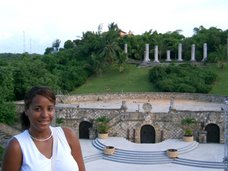As I was looking for information to help me predict the school of the future, I came to realize that first I needed to get to know how the minds of today’s student work. By understanding how students think, we are better able to teach them. Because of this, I came to the conclusion that schools of the 21st century would be shaped or tailored according to their thinking. Caught in the web, I noticed how many windows I needed to tab in order to jump from one to the other to get the most of it. I then realized this is how the student’s mind must work, one that can multitask. One page after the other, video clips, homework assignments, music in their ears, a cell phone with a text message waiting to be answered, and the ever frequent call into the next room, “Yes mom, I’ll be there in just a sec!” Seriously, are the schools ready to meet this challenge?
Society changes, technology changes, students change, therefore schools must change as well. For instance, I would like to take you back about 100 years to the turn of the 20th century. Notice an article I found, Technology Explosion: Early 20th Century written by Lynn Browne, July 2003. In part, the article states: “The pace of economic growth was very rapid in the years around the turn of the 20th century… Technological advances in different areas were combined to produce new products and new systems that had profound consequences for the ways in which people lived. Although individual initiative and luck continued to play important roles, the pursuit of technological advances became more formalized in universities and businesses. This was the age of mass production… bringing more and more products within the reach of more and more people”…“This period saw important changes in education, …Free education for all was widely supported as a way to ensure that children learned civic values and that immigrant children were introduced to the prevailing culture. … In the early 20th century, curriculums became more practical …”
Do we see the similarities? Sure the technologies that we have at the turn of this century are far more advanced than those in the early 1900’s but did those advances of their time make any less impact on their lives? We stand placed at the same threshold. Another technological explosion has taken place and again we must adjust to it, in every aspect of our life. Where do we start? The most logical conclusion would be in the area of education of course. Doesn’t everything start there? I find it interesting that one thing stated above was that they wanted to ensure “…that immigrant children were introduced to the prevailing culture. …” It is interesting to see where we have changed in that respect. Now emphasis is being placed on teaching multicultural education, learning about their culture, their background and then we know better how to instruct them about ours. Another thing to take note of is the comment above, “curriculums became more practical”. They became practical in that they conformed or changed to fit the needs of what was going on in the world around them. Since we have experienced another explosion, only this time more extreme, even more so do we need a change in the education system.
The article “Possibilities for 21st Century Education” written by Anne Shaw asks the question, “What is 21st Century Education?” It answered, “It is bold. It breaks the mold. It is flexible, creative, challenging, and complex. It addresses a rapidly changing world filled with fantastic new problems as well as exciting new possibilities…It is abandonment, finally, of textbook-driven, teacher-centered, paper and pencil schooling. It means a new way of understanding the concept of “knowledge”, a new definition of the “educated person”. A new way of designing and delivering the curriculum is required.” Can it be defined any better? I think not.
Speaking of definitions, all of these changes have brought about a change in the definitions of the terms that have become synonymous with education. Here is a list of the terms and what the American Association of School Administrators offers as to a new way of defining them:
· "Schools" will go “from ‘buildings’ to nerve centers, with walls that are porous and transparent, connecting teachers, students and the community to the wealth of knowledge that exists in the world.”
· “Teacher” - From primary role as a dispenser of information to orchestrator of learning and helping students turn information into knowledge, and knowledge into wisdom. The 21st century will require knowledge generation, not just information delivery, and schools will need to create a “culture of inquiry”.
· "Learner” - In the past a learner was a young person who went to school, spent a specified amount of time in certain courses, received passing grades and graduated. Today we must see learners in a new context:
o “First – we must maintain student interest by helping them see how what they are learning prepares them for life in the real world.
o “Second – we must instill curiosity, which is fundamental to lifelong learning.
o “Third – we must be flexible in how we teach.
o “Fourth – we must excite learners to become even more resourceful so that they will continue to learn outside the formal school day.”
What about technology in the 21st century school? The above article stated “There should be full access to technology… If we can, we will obtain laptops for every student and teacher. Buildings will need to be wired in such a way that students can access their files, as well as the Internet, from anywhere in the school. Various labs and learning centers should be set up around the campus. Art, music, theatre, television, radio and film studios can be created with relatively small expenditures. All classrooms should have televisions to watch broadcasts created by their school as well as by other schools in the district.” Administrators themselves will be trained in the new technology, in this way the teachers will be fully supported in their professional development and in their use of technology for learning. As far as funding is concerned, local industries will help fund technology in the schools because they know that their future workforce is going to be adequately trained in this area, thus eliminating the need for retraining, therefore the money they invested in the school for technology is paying off for them in the long run. It is a give and take relationship, one that is mutually beneficial for all in the community.
What about the curriculum of the 21st century school? What will it look like? Will we teach skills and content and be done with it there? To the contrary, students will learn how to better use these things and to put it to use through activities and projects and many other technological tools. They will gain knowledge not just by memorizing what is in a textbook but by making practical application of what they learn. They will be given the technological tools to empower them to create projects that can touch the world in a way never before done. They will have the pride that comes along with making a difference, not only in their own lives but in the lives of others. They not only acquire the skills, but they understand in a way that allows for the application of them. What more could we ask, than to have educated the students with the skills that will get them through the rest of their lives, productively.
As an educator, I have started to do my homework. This week, I went to the Mid-Atlantic Handheld and Emerging Technology Conference. There I learned a good amount of technology tools that I can use to enrich the students’ experience in my Spanish class. I strongly recommend you to watch a video posted here. Have you been paying attention to how your students learn? Are you ready to teach in the 21st Century schools? I don’t know if I am, but I know that I am ready for the challenge. Click on this video and you will hear a prediction of what the future will look like. In the school of the future you discover the talent that your students have and you didn’t even know they had it. Computers don’t get tired of repeating the same thing over and over again and allow students to collaborate, create, and be themselves. Computers should not do it all alone. I truly invite you to take part in this change for the best for our students. Let’s teach them in ways that they understand. In the process, we will eliminate the disconnect that exists between schools and students of today.
Friday, July 27, 2007
Subscribe to:
Post Comments (Atom)


3 comments:
Isn't this ironic, that these students are at the height of the 21st century? Thanks so much for your kindness shown at the conference, it is nice to meet others who share in the same interests. I really learnes quite a bit-I hope I can retain the info.
Very well said!! I like the way that you show how everything is changing and then kind of challenge how are schools changing. We all know that school usually react well to a challenge. Just look at No Child Left Behind Act....That put a challenge out to school and look how we are all busting our you know whats to meet that challenge. I like the way that your thinking and I'm sure your kids will appreciate it too.
BTW, your movie maker has been posted online. http://mahetc2007.wikispaces.com/Participant+Movies
Excellent job on that.
Post a Comment